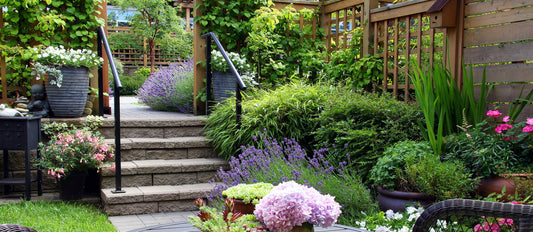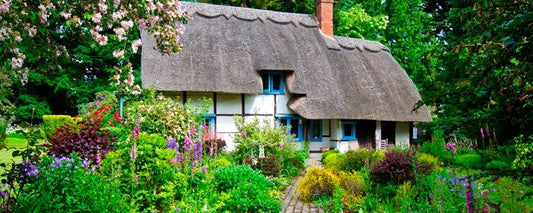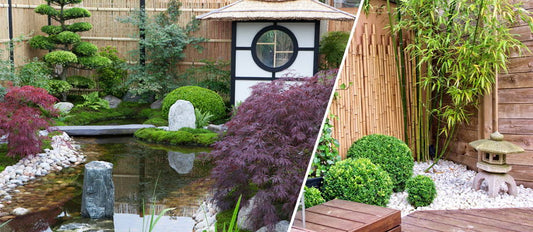Do you want to cool off in your own garden this summer? But you want to the hassle of maintaining a pool? Then install a swimming pond! The word says it all, this is a pond that is not only suitable for water plants and creatures, but people, too. Aside from needing less maintenance, a swimming pond has many more advantages. You can find everything you need to know here.
What does a swimming pond involve?
A swimming pond is the natural version of a swimming pool. It's fantastic for cooling off in the summer. There are different types of swimming ponds.
The natural pond is part of your garden. It has the shape of a pond that you might encounter in your village or town. A pond has pond plants in it to provide natural purification. The waterside and marsh plants provide a beautiful transition from pond to garden. Combine your swimming pond with a wooden platform to really feel like a fisherman.
The formal swimming pond is more like a swimming pool. The swimming area and the plant area are clearly separated. The plant section has a water purifying function. You've got to admit it, a pond full of water plants is a beautiful sight. The swimming area does not contain plants or animals. That way you can have a good swim without having to look out for plants or animals. A water pump is used to pump the purified water to the bathing basin. So you can swim in clean, clear water.
Would you rather swim with your fish? Then put in a fish pond! Is your preference for big koi carp or smaller fish? Always install a pond at least 80 cm deep so that the fish have enough space to live well. A pond with lots of fish cannot be kept clean only by plants. This pond will require a purification pump. Then you can have fun swimming! Watch out not to step on a fish.
Why choose a swimming pond?
Why should I choose a pond over a pool?' is an often-heard question when people first hear about a swimming pond. What many people do not know is that a swimming pond has many advantages. It is easier to maintain than a swimming pool. The pond plants and natural bacteria take the majority of the work out of your hands. They purify the water and keep algae away, keeping the water clean. However, you should occasionally remove leaves and twigs of trees or shrubs in the garden from your swimming pond. The pond is therefore cared for in a natural way. This eliminates the need for chlorine to keep the water clean.
You are also giving nature a helping hand. With a pond, you give aquatic animals a place to shelter. The plants, like other plants, also remove CO2 from the air and emit oxygen. So you're giving back to nature, in a small way. With a pool, you don't have the green component.
A pond, moreover, really completes your garden, forming a whole with the rest of the plants and the interior.
What do I need to have a swimming pond in my garden?
- Plenty of space in the garden. You want to be able to have a proper swim, of course. Make a plan in advance of how long, wide and deep your swimming pond will be and how you want to design it. We recommend that you hire a company for actual construction. The larger the pond, the more difficult it is to build.
- A circulation pump to allow the water to flow. This will prevent the wrong bacteria from entering the water. This pump also transfers the water from the purification basin to the swimming basin in a formal swimming pond.
- Oxygenating plants are essential to keep a pond algae-free, keeping the water clear and healthy. These plants absorb CO2 from the pond water and release oxygen into the water. This is good for life in the pond.
- Floating plants, like oxygenating plants, help to keep algae away. They do this by removing the salt from the water. Floating plants are not planted on the bottom, as is the case with other pond plants. Place these plants on the water and the roots of the leaves extract food from the water.
- Waterside plants and marsh plants are perfect for softening the transition at the edges of the pond. Marsh plants are located just in the water and will part nicely as you enter the water. Waterside plants are on dry land. They don't like to have their roots constantly underwater but they can handle water. These plants often add the colour to your swimming pond.
How do I maintain my swimming pond?
A swimming pond is easy to care for, but the placement is important. Place the swimming pond away from the trees and shrubs that shed leaves. This prevents you from having to fish leaves out of the water too often. You also want to have a sunny spot. The pond plants love plenty of sunlight and of course you will too when you are in the water. It is also important to cut back the pond plants once or twice a year. You can cut back up to about 1/3 of their length. Note that some plants can't have their leaves or flowers in the water. This is indicated on the plant label.
It is also very important for the plants that you keep the pH value of the water at the proper level. Rain will reduce the hardness of the water. This makes plant survival harder and harder. The plants may die and algae can then run amok. Test the quality of the water now and then. This test checks the hardness of the water but also the amount of nutrients. When nutrients are low, add more. Use pond substrate for this.
Have you already been persuaded to make a swimming pond?




